
Back to Basics: January 2014
Mark Van
Features Fire Ground TrainingThe Pittsburgh drill is a scenario-based drill that incorporates many skills. It also emphasizes teamwork, communication and an effective use of time during the rescue of a downed firefighter.
The Pittsburgh drill is a scenario-based drill that incorporates many skills. It also emphasizes teamwork, communication and an effective use of time during the rescue of a downed firefighter.
The drill was developed in Pittsburgh after the Bricelyn Street fire on Feb. 14, 1995, claimed the lives of three firefighters. This fire exposed the need to develop RIT training. Assistant Chief James Crawford, from Midway, S.C., was a firefighter with the Pittsburgh Bureau of Fire and was a member of the RIT that was sent in to attempt to rescue those three firefighters. He has talked about how difficult it was to, drag, pull and lift the firefighters out. Crawford has also said that he narrowly made it out himself during that operation. After this incident, Crawford developed a formal RIT training program that has spread across North America.
The three main components of the Pittsburgh drill are based on the Bricelyn Street fire: a low profile (under), a ramp type of obstacle (over) and a tunnel (through). The drill requires the four-member team to work together in an effort to reach the downed firefighter, package him for removal, and then remove him the same way the RIT entered – through an obstacle, over an obstacle and under an obstacle. This must be completed in less than 20 minutes.
This drill tests the limitations of the group and each member in a number of ways – fatigue, stress, communication, timing and critical thinking – and pushes the group to prove its ability to rescue a fellow firefighter. Let’s look at each component of the drill.
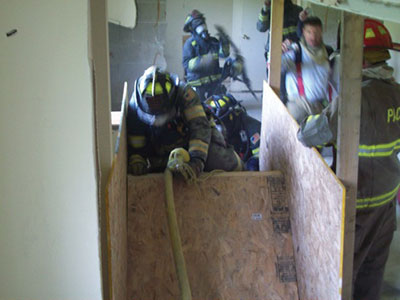 |
|
| Photo 1: When going over an obstacle, RIT members must ensure that the obstacle – and the floor – is strong enough to hold their weight. The first member over the obstacle should proceed feet first, sounding as he goes. Photos by Mark van der Feyst |
|
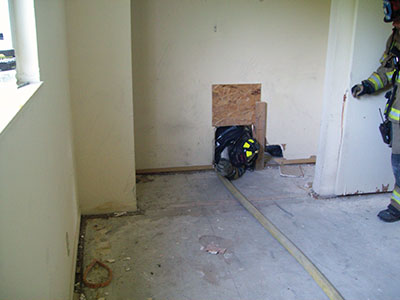 |
|
| Photo 2: Members should make use of basic firefighter survival skills when moving under an obstacle; this includes sounding the floor in front of them and maintaining a firm grasp of their SCBAs, if low-profiling is required. |
|
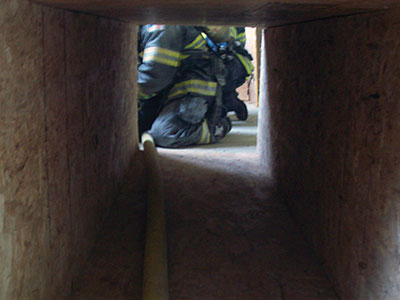 |
|
| Photo 3: The length of the tunnel for the through obstacle should be about 1.8 metres, and can be constructed of a number of materials. | |
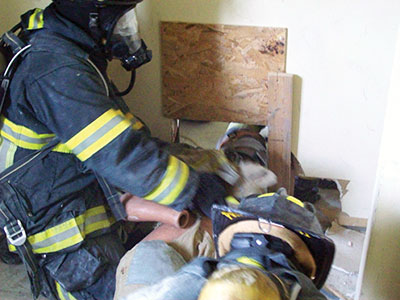 |
|
| Photo 4: Before removing the downed firefighter, ensure that his equipment is secured, and square him with the opening so that he will move through the tunnel with ease. |
|
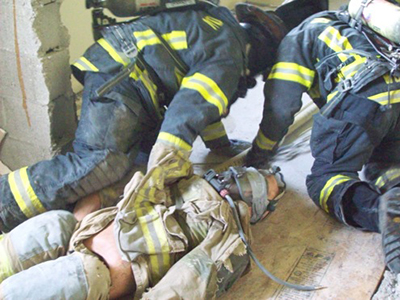 |
|
| Photo 5: Communication is vital so that the two RIT members are not pulling the downed firefighter too hard and too quickly, which could pull off his SCBA or cause him more injury.
|
First, the team needs to have the proper equipment ready before the drill can start. This includes a set of hand tools, such as a Haligan and an axe, and a rope bag with webbing for the packaging and removal. The team follows a charged hoseline into the structure, which leads team members to the downed firefighter.
Over
Going over an obstacle, as in photo 1, requires team members to ensure that the obstacle – and the floor – is strong enough to hold their weight. The first person to go over the obstacle sounds as he goes, and goes down the other side of the obstacle feet first. Once over, he needs to let the other team members know it is safe for them to move over the obstacle. Once over, the first team member can find the hoseline and continue following it to the downed firefighter.
Under
The under obstacle is set up as a hole in the base of a wall near the floor (see photo 2). The size of the hole can vary from 90 square centimetres (14 square inches) to 154 square centimetres (24 square inches). RIT members may have to low-profile their SCBAs to navigate through the hole. Members should make use of basic firefighter survival skills and go through the hole head first, sound the floor in front of them and maintain a firm grasp of their SCBAs. Once through, members don their SCBAs and continue to the tunnel.
Through
The tunnel size can vary depending upon what you use; for example, you can build a wooden box tunnel with an opening of 154 square centimetres (24 square inches), or you can weld together two 204-litre (45-gallon) drums with an opening of 103 square centimetres (16 square inches). The length of the tunnel should be about 1.8 metres (six feet), as in photo 3. Regardless of the size of opening, RIT members may have to low-profile here as well. Only two team members will go through the tunnel; the other two should be staged at the opening of the tunnel.
Once the first two RIT members locate the downed firefighter, they package him for removal. This is the point at which the webbing comes into play. If low-profiling is required, the downed firefighter’s SCBA can be removed and secured to the webbing that is placed around the downed firefighter’s chest using a girth hitch. Tie an overhand knot on the webbing loop a little bit above the firefighter’s head. The other two RIT members staged at the tunnel opening should have in their hands the ends of the rope that is attached to the webbing piece. This rope, equipped with a carabiner, will snap into the webbing loop.
Once everything is secured, the removal can start. Square the downed firefighter with the openings so that he will travel through the tunnel and the under obstacle with ease, as in photo 4.
Communication is vital so that the two RIT members are not pulling too hard and too fast, pulling off SCBA, or causing more injury to the downed firefighter. As you can see in photo 5, the SCBA was pulled off the downed firefighter in the RIT members’ haste to remove him.
The Pittsburgh drill tests the limitations of the team and of each individual. It is also a fun drill to run as it creates competition
among teams.
Mark van der Feyst is a 15-year veteran of the fire service. He works for the City of Woodstock Fire Department in Ontario. Mark instructs in Canada, the United States and India and is a local-level suppression instructor for the Pennsylvania State Fire Academy and an instructor for the Justice Institute of B.C. E-mail Mark at Mark@FireStarTraining.com
Print this page